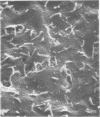Abstract
fu-1 cells, a line of rat myoblasts defective in differentiation, can be fused into multinucleate syncytia by Moloney murine leukemia virus. The effects of treating the virus with specific antibody, UV irradiation, and elevated temperature and the requirements for cellular RNA and protein synthesis have been studied as they relate to this virus-induced fusion. The results indicate that intact, but not necessarily infectious, virions are required to promote fusion of fu-1 cells. Neither actinomycin D nor cycloheximide altered the formation of syncytia; thus, neither viral nor cellular RNA or protein synthesis is required for fusion. fu-1 cells infected with the ts3 temperature-sensitive mutant of Moloney murine leukemia virus accumlate large amounts of budding virus on their cell membrane; however, this membrane-associated virus failed to induce syncytia. Upon release of the virus at the permissive temperature, fusion did occur. We conclude that contact or attachment of the immature virus to the cell membrane is not sufficient to promote murine leukemia virus-induced cell fusion; complete virions are required. From these data, we propose that adsorption and penetration of the virus may induce a change in the cell membrane that subsequently promotes the fusion of susceptible cells.
Full text
PDF







Images in this article
Selected References
These references are in PubMed. This may not be the complete list of references from this article.
- Ahmed M., Korol W., Larson D. L., Harewood K. R., Mayyasi S. A. Interactions between endogenous baboon type-C virus and oncogenic viruses. I. Syncytium induction and development of infectivity assay. Int J Cancer. 1975 Nov 15;16(5):747–755. doi: 10.1002/ijc.2910160507. [DOI] [PubMed] [Google Scholar]
- Ball J., McCarter J. A., Sunderland S. M. Evidence for helper independent murine sarcoma virus. I. Segregation of replication-defective and transformation-defective viruses. Virology. 1973 Nov;56(1):268–284. doi: 10.1016/0042-6822(73)90305-x. [DOI] [PubMed] [Google Scholar]
- Hampar B., Rand K. H., Lerner R. A., Del Villano B. C., Jr, McAllister R. M., Martos L. M., Derge J. G., Long C. W., Gilden R. V. Formation of syncytia in human lymphoblastoid cells infected with type C viruses. Virology. 1973 Oct;55(2):453–463. doi: 10.1016/0042-6822(73)90187-6. [DOI] [PubMed] [Google Scholar]
- Johnson G. S., Friedman R. M., Pastan I. Analysis of the fusion of XC cells induced by homogenates of murine leukemia virus-infected cells and by purified murine leukemia virus. J Virol. 1971 Jun;7(6):753–758. doi: 10.1128/jvi.7.6.753-758.1971. [DOI] [PMC free article] [PubMed] [Google Scholar]
- Klement V., Rowe W. P., Hartley J. W., Pugh W. E. Mixed culture cytopathogenicity: a new test for growth of murine leukemia viruses in tissue culture. Proc Natl Acad Sci U S A. 1969 Jul;63(3):753–758. doi: 10.1073/pnas.63.3.753. [DOI] [PMC free article] [PubMed] [Google Scholar]
- McCarter J. A. Genetic studies of the ploidy of Moloney murine leukemia virus. J Virol. 1977 Apr;22(1):9–15. doi: 10.1128/jvi.22.1.9-15.1977. [DOI] [PMC free article] [PubMed] [Google Scholar]
- Poste G., Allison A. C. Membrane fusion reaction: a theory. J Theor Biol. 1971 Jul;32(1):165–184. doi: 10.1016/0022-5193(71)90144-5. [DOI] [PubMed] [Google Scholar]
- Poste G. Mechanisms of virus-induced cell fusion. Int Rev Cytol. 1972;33:157–252. doi: 10.1016/s0074-7696(08)61451-5. [DOI] [PubMed] [Google Scholar]
- Rand K. H., Long C. Syncytial assay for the putative human C-type virus, RD-114, utilizing human cells transformed by Rous sarcoma virus. Nat New Biol. 1972 Dec 6;240(101):187–190. doi: 10.1038/newbio240187a0. [DOI] [PubMed] [Google Scholar]
- Rand K., Davis J., Gilden R. V., Oroszlan S., Long C. Fusion inhibition: bioassay of type C viral protein. Virology. 1975 Mar;64(1):63–74. doi: 10.1016/0042-6822(75)90079-3. [DOI] [PubMed] [Google Scholar]
- Scheid A., Choppin P. W. Identification of biological activities of paramyxovirus glycoproteins. Activation of cell fusion, hemolysis, and infectivity of proteolytic cleavage of an inactive precursor protein of Sendai virus. Virology. 1974 Feb;57(2):475–490. doi: 10.1016/0042-6822(74)90187-1. [DOI] [PubMed] [Google Scholar]
- Scheid A., Choppin P. W. Protease activation mutants of sendai virus. Activation of biological properties by specific proteases. Virology. 1976 Jan;69(1):265–277. doi: 10.1016/0042-6822(76)90213-0. [DOI] [PubMed] [Google Scholar]
- Wong P. K., MacLeod R. Studies on the budding process of a temperature-sensitive mutant of murine leukemia virus with a scanning electron microscope. J Virol. 1975 Aug;16(2):434–442. doi: 10.1128/jvi.16.2.434-442.1975. [DOI] [PMC free article] [PubMed] [Google Scholar]
- Wong P. K., McCarter J. A. Studies of two temperature-sensitive mutants of Moloney murine leukemia virus. Virology. 1974 Apr;58(2):396–408. doi: 10.1016/0042-6822(74)90075-0. [DOI] [PubMed] [Google Scholar]
- Wong P. K., Russ L. J., McCarter J. A. Rapid, selective procedure for isolation of spontaneous temperature-sensitive mutants of Moloney leukemia virus. Virology. 1973 Feb;51(2):424–431. doi: 10.1016/0042-6822(73)90441-8. [DOI] [PubMed] [Google Scholar]
- Wong P. K., Yuen P. H., Kaufman S. J. Induction of syncytia by Moloney murine leukemia virus in myoblasts defective in differentiation. J Virol. 1977 Jan;21(1):319–327. doi: 10.1128/jvi.21.1.319-327.1977. [DOI] [PMC free article] [PubMed] [Google Scholar]



